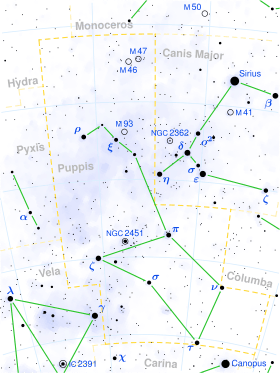HD 64760
HD 64760 (J Puppis) is a class B0.5 supergiant star in the constellation Puppis. Its apparent magnitude is 4.24 and it is approximately 1,660 light years away based on parallax.
| Observation data Epoch J2000 Equinox J2000 | |
|---|---|
| Constellation | Puppis |
| Right ascension | 07h 53m 18.15792s[1] |
| Declination | −48° 06′ 10.5637″[1] |
| Apparent magnitude (V) | 4.24[2] |
| Characteristics | |
| Spectral type | B0.5Ib[3] |
| U−B color index | -0.99[2] |
| B−V color index | -0.14[2] |
| Astrometry | |
| Radial velocity (Rv) | +41.00[4] km/s |
| Proper motion (μ) | RA: -5.60[1] mas/yr Dec.: +5.76[1] mas/yr |
| Parallax (π) | 1.97 ± 0.10[1] mas |
| Distance | 1,660 ± 80 ly (510 ± 30 pc) |
| Absolute magnitude (MV) | -4.30[5] |
| Details | |
| Mass | 15.5[6] M☉ |
| Radius | 21.6[7] R☉ |
| Luminosity | 155,000[7] L☉ |
| Temperature | 24,600[7] K |
| Rotation | 98.9 hours[7] |
| Rotational velocity (v sin i) | 238[3] km/s |
| Other designations | |
| Database references | |
| SIMBAD | data |
The stellar wind structure of HD 64760 has been extensively studied. Its spectrum shows classic P Cygni profiles indicative of strong mass loss and high-velocity winds, but the spectral line profiles are also variable. The variation shows a 2.4 day modulation which is caused by non-radial pulsation of the star itself. Other pulsation periods around 4.81 hours have also been identified.[7]
HD 64760 rotates rapidly. Despite its large size it completes a rotation every 4.1 days compared to every 27 days for the sun. This causes the star to be an oblate spheroid, with the equatorial radius 20% larger than the polar radius. It is estimated that the temperature of the photosphere is 23,300 K at the equator and 29,000 K at the poles, due to gravity darkening. In addition, the surface has temperature variations due to its pulsations. The effective temperature for the star as a whole is 24,600 K, to match the bolometric luminosity of 155,000 L☉.[7]
References
- Van Leeuwen, F. (2007). "Validation of the new Hipparcos reduction". Astronomy and Astrophysics. 474 (2): 653. arXiv:0708.1752. Bibcode:2007A&A...474..653V. doi:10.1051/0004-6361:20078357. Vizier catalog entry
- Ducati, J. R. (2002). "VizieR Online Data Catalog: Catalogue of Stellar Photometry in Johnson's 11-color system". CDS/ADC Collection of Electronic Catalogues. 2237. Bibcode:2002yCat.2237....0D.
- Hoffleit, D.; Warren, W. H. (1995). "VizieR Online Data Catalog: Bright Star Catalogue, 5th Revised Ed. (Hoffleit+, 1991)". VizieR On-line Data Catalog: V/50. Originally Published in: 1964BS....C......0H. 5050. Bibcode:1995yCat.5050....0H.
- Gontcharov, G. A. (2006). "Pulkovo Compilation of Radial Velocities for 35 495 Hipparcos stars in a common system". Astronomy Letters. 32 (11): 759. arXiv:1606.08053. Bibcode:2006AstL...32..759G. doi:10.1134/S1063773706110065.
- Anderson, E.; Francis, Ch. (2012). "XHIP: An extended hipparcos compilation". Astronomy Letters. 38 (5): 331. arXiv:1108.4971. Bibcode:2012AstL...38..331A. doi:10.1134/S1063773712050015. Vizier catalog entry
- Tetzlaff, N.; Neuhäuser, R.; Hohle, M. M. (2011). "A catalogue of young runaway Hipparcos stars within 3 kpc from the Sun". Monthly Notices of the Royal Astronomical Society. 410: 190. arXiv:1007.4883. Bibcode:2011MNRAS.410..190T. doi:10.1111/j.1365-2966.2010.17434.x. Vizier catalog entry
- Kaufer, A.; Prinja, R. K.; Stahl, O. (2002). "Evidence for a connection between photospheric and wind structure in HD 64760". Astronomy and Astrophysics. 382 (3): 1032. Bibcode:2002A&A...382.1032K. doi:10.1051/0004-6361:20011649.
